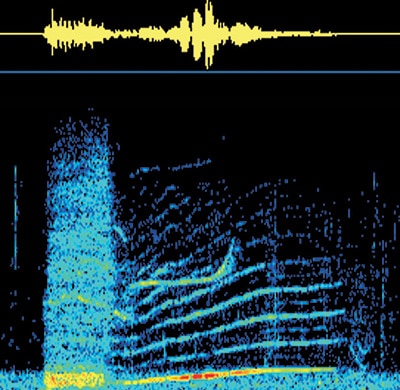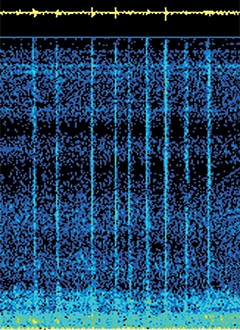Sound in the Sea
Sound waves travel through water at a speed of about 1.5 km/sec (0.9 mi/sec), which is 4.5 times as fast as sound traveling through air.
Killer whales probably rely on sound production and reception to navigate, communicate, and hunt in dark or murky waters. Under these conditions, sight is of little use.
Sound Production
Killer whales produce sounds for two overlapping functions: communicating and navigation (in the form of echolocation).
Killer whales produce whistles, echolocation clicks, pulsed calls, low-frequency pops, and jaw claps.
A killer whale makes sounds by moving air between nasal sacs in the blowhole region.
- In contrast, a human makes sound by forcing air through the larynx. The vocal cords in the larynx vibrate as air flows across them, producing sounds. Our throat, tongue, mouth and lips shape these sounds into speech. The larynx of a killer whale does not have vocal cords.
- A tissue complex in a toothed whale's nasal region, called the dorsal bursa, is the site of sound production. This complex includes "phonic lips" (sometimes called "monkey lips") — structures that project into the nasal passage. Toothed whales make at least some sounds by forcing air through the nasal passage and past the phonic lips: the surrounding tissue vibrates, producing sound.
- Releasing air isn't required for sound production. During some vocalizations, killer whales actually release air from the blowhole, but these bubble trails and clouds are probably a visual display.

Communication
Killer whales use whistles for close-range, or private, communication and coordination of behavioral interactions between animals. Whistles are high pitched, show a high degree of directionality and are highly modulated, as a result, they don't carry far underwater.
- The frequency of killer whale whistles ranges from about 0.5 to 40 kHz, with peak energy at 6 to 12 kHz.
- Studying northern resident killer whales, researchers found that the whales produced more whistles when they were close to other individuals and only sporadically emitted them when the whales were dispersed over larger areas.
- Transient killer whales also use whistles, but more sparingly and have a smaller repertoire in comparison to residents.

Pulsed calls may function in group recognition and coordination of behavior.
Pulsed calls are the most common vocalization of killer whales.
- Experts think these calls function in group recognition and coordination of behavior.
- Killer whales make these calls at frequencies of about 0.5 to 25 kHz, with peak energy at 1 to 6 kHz.
Calls that sound the same time after time are called stereotyped calls. All a killer whale's stereotyped calls make up that whale's repertoire.
The individuals of any particular pod share the same repertoire of calls, a vocalization system called a dialect.
- Although scientists have noted that there is some type of structure to the calls, a dialect is not the same thing as a language.
- Analysis of killer whale call patterns has demonstrated substantial differences between the dialects of different pods.
- Pods that associate with one another may share certain calls. Pods that share calls are called a clan.
- Pods may share a certain level of their repertoire with other pods while other portions are unique. The more similarities they share may indicate the degree the pods and individuals are related.
- No two pods share the entire repertoire. Thus, each pod has its own unique dialect. In fact, the vocal repertoires of each pod remain distinct enough that scientists can identify pods by the sounds they make.
- Killer whales that are separated by great geographical distances have completely different dialects. An analysis of Icelandic and Norwegian killer whale pods revealed that the Icelandic population made 24 different calls and the Norwegian whales made 23 different calls, but the two populations did not share any of the same calls.

A calf is most likely to develop calls like those of its mother. Vocal development studies at SeaWorld have determined that a calf learns its repertoire of calls selectively from its mother, even when other killer whales may be present and vocalize more frequently than the mother.
- A calf can vocalize within days of birth, but sound production is shaped with age. A calf's first vocalizations are "screams" — loud, high-pitched calls that bear no resemblance to adult-type calls.
- At about two months, a calf produces its first pulsed calls with similarities to adult-type calls.
- Vocal behavior appears not to be genetically predetermined. Calves learn which calls to make and under what circumstances.
- From two to six months, a calf's repertoire increases. Calves continue to learn calls until puberty.
Like many other animals, toothed whales may also communicate using a variety of postures and gestures. Some behaviors, such as head-butting and jaw-snapping, are usually assumed to communicate aggression. The purpose of other behaviors, including breaching and pec-slapping, is not clearly understood.
Echolocation
The term echolocation refers to an ability that odontocetes (and some other marine mammals and most bats) possess that enables them to locate and discriminate objects by projecting high-frequency sound waves and listening for echoes.
A killer whale echolocates by producing clicks and then receiving and interpreting the resulting echo.
- The echolocating killer whale uses its phonic lips to produce directional, broadband clicks in rapid succession, called a train. Each click lasts less than one millisecond. One study of resident killer whales measured broadband, bimodal echolocation clicks that typically showed low frequency peaks between 20 to 30 kHz and high frequency peaks between 40 to 60 kHz.
- The click trains pass through the melon (the rounded region of a killer whale's forehead), which consists of lipids (fats). The melon acts as an acoustical lens to focus these sound waves into a beam, which is projected forward into water in front of the whale.
- The sound waves produced by a killer whale bounce off objects in the water, and their echoes return to the killer whale.
- The major areas of sound reception are the fat-filled cavities of the lower jaw bones. Sounds are received and conducted through the lower jaw to the middle ear, inner ear, and then to hearing centers in the brain via the auditory nerve.

A killer whale echolocates by producing clicks.
Killer whales often need to navigate in the absence of light/good visibility. Therefore, hearing is essential to them. The killer whale's primary sensory system is the auditory system. It is a highly-developed system that includes biological sonar ability or echolocation. Echolocation helps killer whales determine the size, shape, structure, composition, speed, and direction of an object.
Relationship to Feeding Habits
The use of echolocation and calls may vary greatly between fish-eating and mammal-eating populations of killer whales.
In the North Pacific, resident killer whales are more vocal and 27 times more likely to be producing click trains for echolocation. These differences are likely due to the fact that transients attempt to prey upon other types of marine mammals, which have more acute hearing in the frequency range of sonar clicks compared to fish. In an attempt to go unnoticed, studies suggest that transient killer whales use passive listening more to detect and locate marine mammal prey instead of relying on echolocation.




